1996 PONTIAC GRAND-AM engine overheat
[x] Cancel search: engine overheatPage 206 of 356
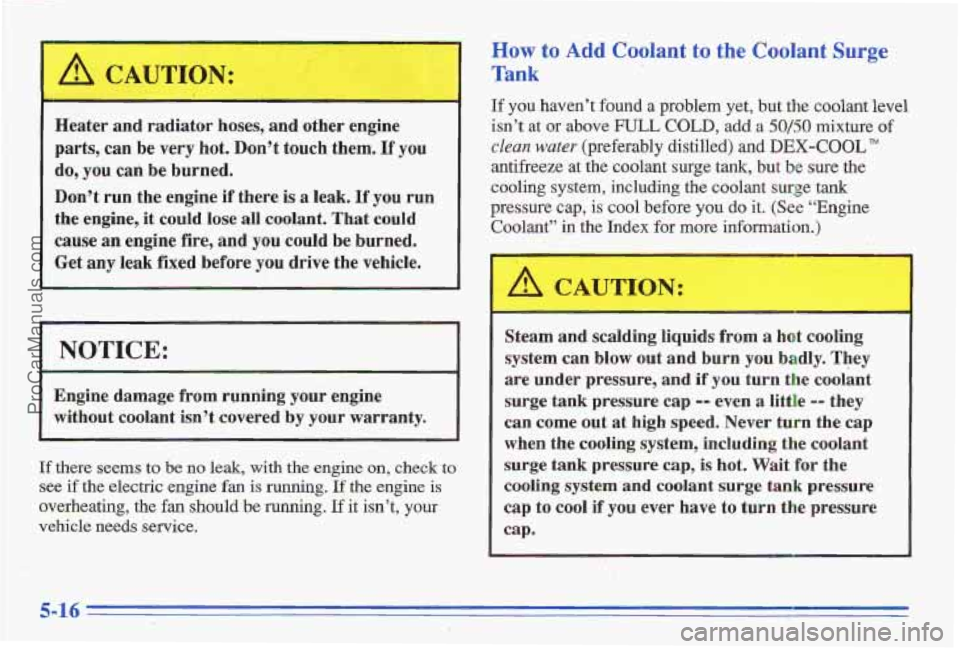
6!!l CAUTION:
~~~ ~
Heater and radiator hoses, and other engine
parts, can be very hot. Don’t touch them.
If you
do, you can be. burned.
Donst run the engine
if there is a leak. If you run
the engine, it could
lose all coolant. That coulld
cause an engine
fire, and you could be burned.
Get
any leak fixed before you drive the vehicle.
without coolant isn’t covered
by your warranty.
If there seems to be no leak, with the engine on, check to
see if the electric engine fan is running. If the engine is
overheating, the fan should be running. If it isn’t, your
vehicle needs service.
How to Add Coolant to the Coolant Surge
Tank
If you haven’t found a problem yet, but the coolant level
isn’t at
or above FULL COLD, add a 50150 mixture of
clean water (preferably distilled) and DEX-COOL
antifreeze at the coolant surge tank, but be sure the
cooling
system, including the coolant surge tank
pressure cap,
is COO^ before you do it, (See “Engine
Coolant” in the Index for more infomati .) - --
I
Steam and scalding liquids from a hot cooling
system can blow out and burn you badly. They
are under pressure, and
if you turn the coolant
surge tank pressure cap
-- even a little -- they
can come out at high speed. Never turn the cap
when the cooling
system, including the coolant
surge tank pressure
cap, is hot. Wait for the
cooling system and coolant
surge tank pressure.
cap to cool if you ever have to turn the pressure
cap.
5-16
ProCarManuals.com
Page 207 of 356
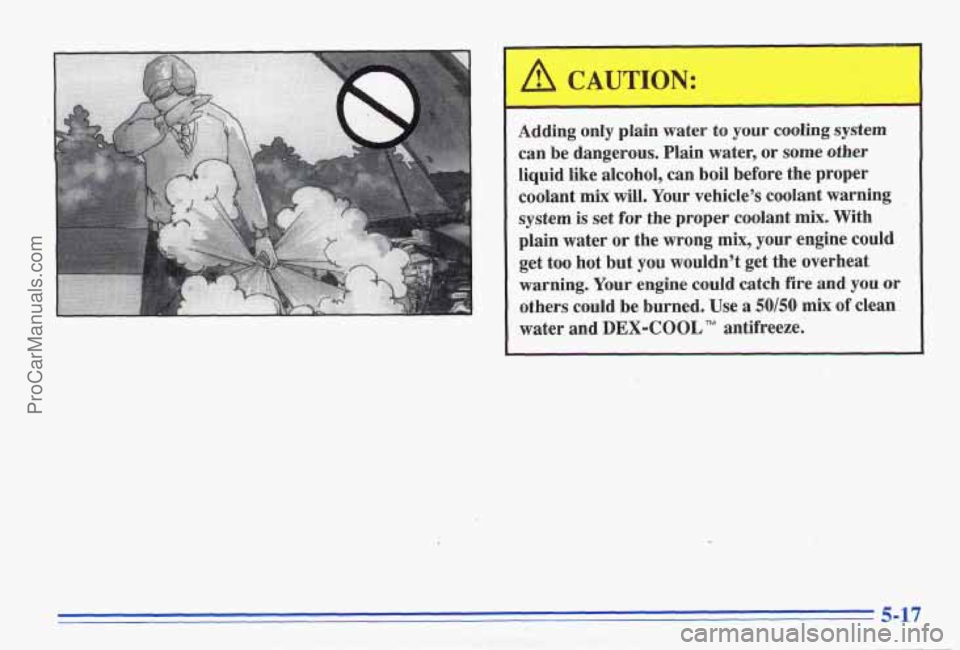
Adding only plain water to your cooling system
can be dangerous. 'Plain water, or
some other
liquid like alcohol, can boil before the proper
coolant
mix' will. Your vehicle's coolant warning
system is set
for the proper coolant mix. With
plain water
or the wroug mix, your engine could
get too hot but you wouldn't get the overheat
warning. Your engine could catch.fire and you
or
others could be burned. Use a 50150 mix of clean
water and
DEX-COOL TM antifreeze.
ProCarManuals.com
Page 222 of 356
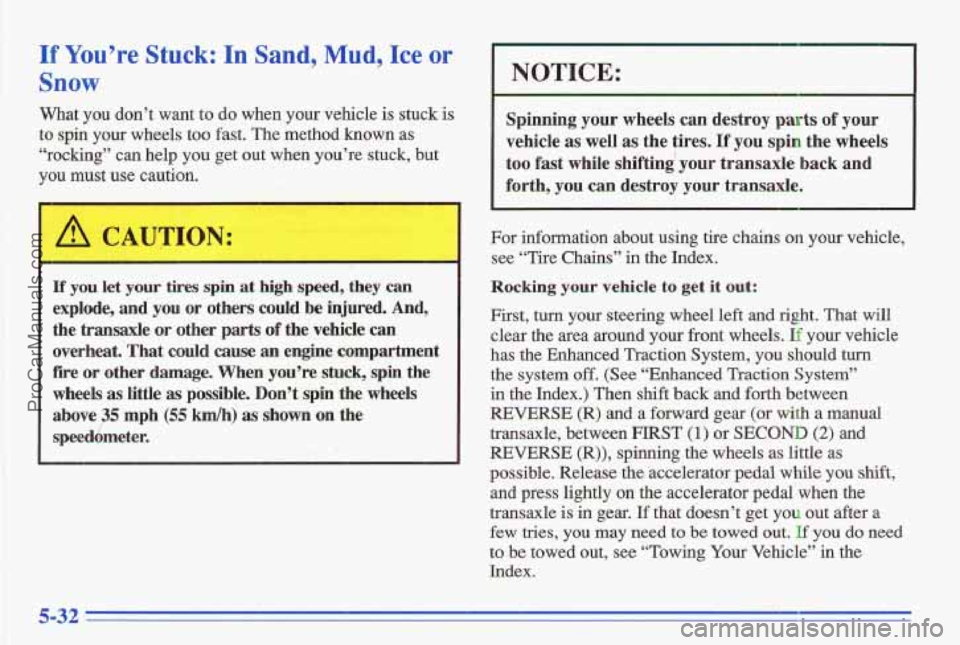
If You’re Stuck: In Sand,,Mud, Ice or
Snow
What you don’t want to do when your vehicle is stuck is
to spin your wheels too fast. The method known a,s
“rocking” can help you get out when you’re stuck, but
you must use caution.
/d CAUTION:
If you your .es spin at high speed, they can
explode, and you or others could be injured. And,
the tran,saxle or other parts of the vehicle can
overheat.
That could cause an engine compartment
fire or other damage. When you’re stuck, spin the
wheels
as little as possible. Don’t spin the wheels
above35 mph
(55 kdh) as shown on the
speedqmeter. Spinning
your wheels can destroy
parts of your
vehicle as well
as the tires. If you spin the wheels
too fast while shifting your transaxle back and
For information about using tire chains on your vehicle,
see “Tire Chains” in the Index.
Rocking y---r vehick ID get it out:
First, turn your steering wheel left and right. That will
clear the pea around your front wheels. If your vehicle
has the Enhanced Traction System, you should turn
the system
off. (See “Enhanced Traction System’’
in the Index.) Then shift back and forth between
REVERSE (R) and a forward gear
(or with a manual
transaxle, between FIRST
(1) or SECOND (2) and
REVERSE
(R)), spinning the wheels as little as
possible. Release the accelerator pedal
while you shift,
and press lightly on the accelerator pedal when the
transaxle is in gear.
If that doesn’t get you out after a
few tries, you may need to be towed out. If you do need
to be towe’d out, see “Towing Your Vehicle” in the
Index.
5-32
ProCarManuals.com
Page 244 of 356
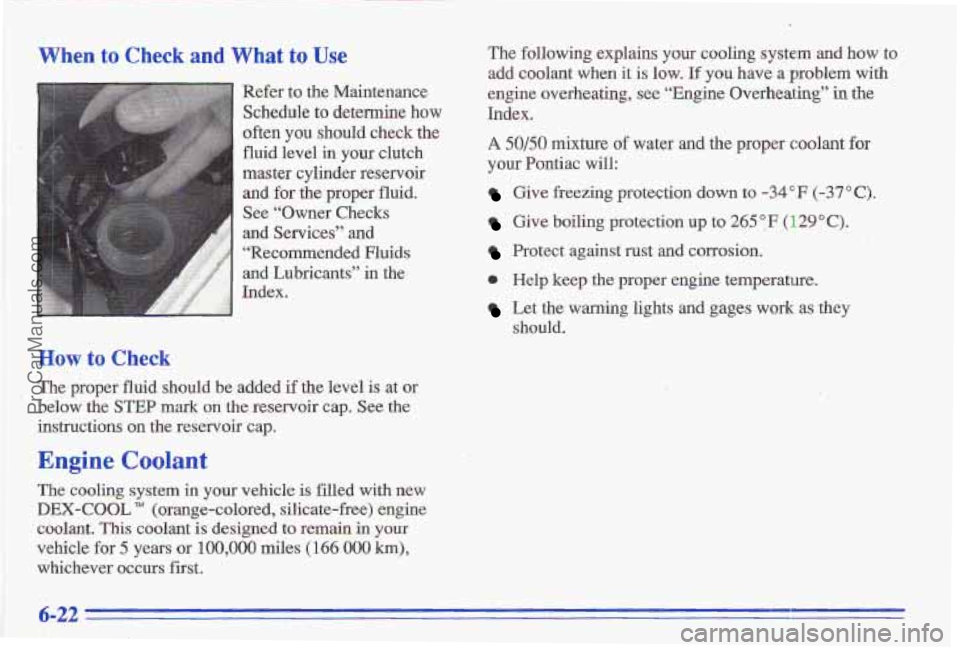
When to Check and What to Use
Refer to the Maintenance
Schedule
to determine how
often you should check the
fluid level
in your clutch
master cylinder reservoir and for
the proper fluid.
See “Owner Checks
and Services” and
“Recommended Fluids
and Lubricants” in the
How tu Check
The proper fluid should be added if the level is at or
below the
STEP mark on the reservoir cap. See the
instructions
on the reservoir cap.
Engine Coolant
The cooling system in your vehicle is filled with new
DEX-COOL TM (orange-colored, silicate-free) engine
coolant.
This coolant is designed to remain in your
vehicle
for 5 years or 100,000 miles (166 000 h),
whichever occurs first. The
following explains
your cooling system and how to
add coolant when it is low. If you have a problem with
engine overheating, see “Engine Overheating”
in the
Index.
A Sol50 mixture of water and the proper coolant for
your Pontiac will:
Give freezing protection down to -34°F (-37°C).
Give boiling protection up to 265 9 F ( 129 O C).
Protect against rust and corrosion.
0 Help keep the proper engine temperature.
Let the warning lights and gages work as they
should.
6-22
ProCarManuals.com
Page 245 of 356
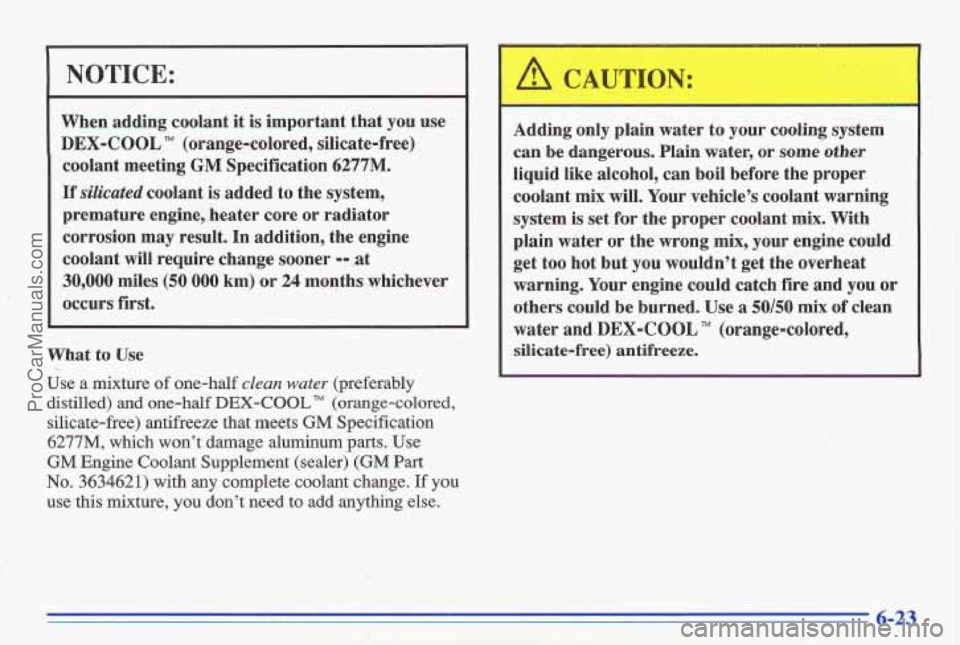
NOTICE:
When adding coolant it is important that you use
DEX-COOL TM (orange-colored, silicate-free)
coolant meeting
GM Specification 6277M.
If silicated coolant is added to the system,
premature engine, heater core or radiator
corrosion may result. In addition, the engine
coolant will require change sooner --,at
30,000 miles
(50 000 km)'or 24 months whichever
occurs first.
What to Use
Use a mixture of one-half clean water (preferably
distilled) and one-half
DEX-COOL TM (orange-colored,
silicate-free) antifreeze that meets GM Specification
6277M, which won't damage aluminum parts. Use
GM Engine Coolant Supplement (sealer) (GM Part
No. 3634621) with any complete coolant change. If you
use this mixture, you don't need to add anything else.
.
Adding only plain water to your cooling system
can be dangerous. Plain water,
or some other
liquid like alcohol, can bo'il before the proper
coolant mix will. Your vehicle's coolant warning'
system is set for the proper coolant mix. With
plain water or the wrong mix, your engine could
get too hot but you wouldn't get the overheat
warning. Your engine could catch
fire and you or
others could be burned. Use a 5060 mix of clean
water and
DEX-COOL (orange-colored,
silicate-free) antifreeze.
f' . ..
ProCarManuals.com
Page 246 of 356

NOTICE:
If you use an improper coolant mix, your engine
could overheat and be badly damaged. The
repair cost wouldn’t be covered by your
warranty. Too much water
in the mix can freeze
and crack the engine, radiator, heater core and
other parts.
If you have to add cooldnt more than four times a year,
have
your dealer check your cooling system,
I NOTICE:
If you use the proper coolant, you don’t have to
add extra inhibitors or additives which claim to
improve the system. These can be harmful.
Checking Coolant
The coolant surge tank is located on the passenger side
of the engine compartment.
0
ProCarManuals.com
Page 248 of 356
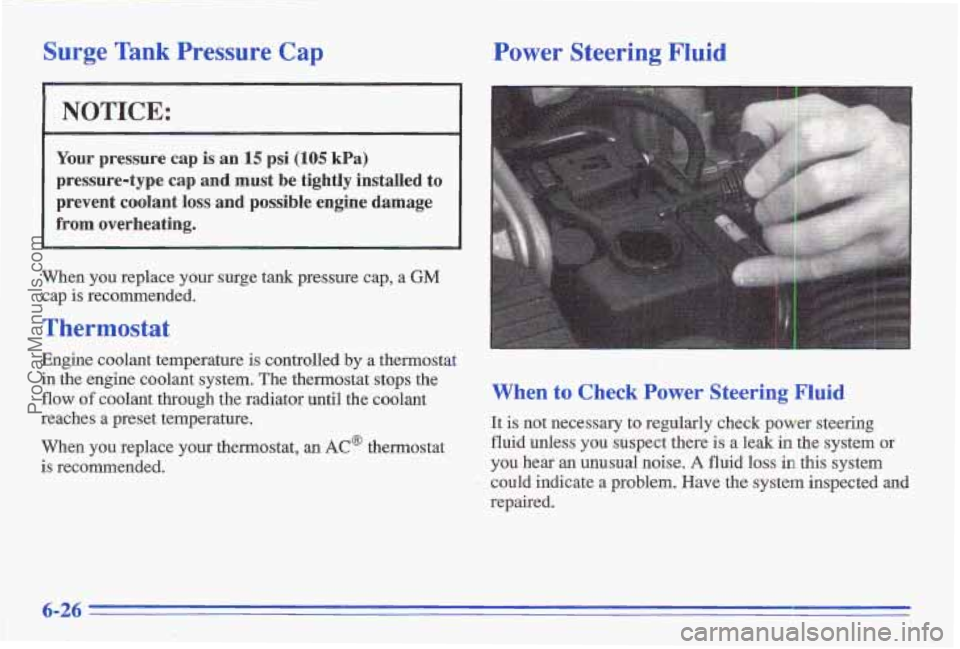
Surge Tank Pressure Cap
NOTICE: ~~ ~
Your pressure cap is an 15 psi l(105 kPa)
pressure-type cap and must be tightly installed to
prevent coolant loss and possible engine damage
from overheating,
When you replace your surge tank pressure cap, a GM
cap is recommended.
Thermostat
Engine coolant temperature is controlled by a thermostat
in the engine coolant system, The thermostat stops the
flow of coolant through the radiator until the coolant
reaches
a preset temperature.
When you replace your thermostat,
an AC@ thermostat
is recommended.
Power Steering Fluid
When to Check Power Steering Fluid
It is not necessary to regularly check power steering
fluid unless
you suspect there is a leak in the system or
you hear an unusual noise. A fluid loss in this system
could indicate a problem. Have the system inspected
and
repaired.
6-26
ProCarManuals.com
Page 346 of 356

Engine .................................... 6-8. 6.9
Coolant ..................................... 6-22
Coolant Heater ................................ 2-16
Codant Level Check ........................... 7-37
Exhaust ..................................... 2-28
Fuse Block .................................. 6-58
Identification ................................. 6-53
Oil Level Check .............................. 7-37
Overheating .................................. 5-12
Ruining While Parked ......................... 2-29
Specifications
................................ 6-61
Starting
..................................... 2-13
Engineoil
.................................... 6-10
Adding ..................................... 6-12
Additives ................................... 6-14
Checking .................................... 6-11
Used ....................................... 6-15
WhatToUse ................................. 6-13
When to Change
.............................. 6-15
Enhanced Traction System Active Light
........ : 2-59. 4-8
. Coolant Temperature Gage ..................... 2-59
Enhanced Traction System Warning Light ........ 2-58. 4-9
Ethanol ........................................ 6-3
Exhaust. Engine ................................. 2-28
'Fabric
Cleaning ............................... 6-46
Fifth Gear. Manual Transaxle ..................... 2-21
Filling Your Tank ................................. 6-4
Filter, Air ..................................... 6-16
FinishDamage
................................. 6- 51
First Gear. Automatic Transaxle ................... 2-20.
FinishC .. .................................... 6-49 First
Gear. Manual Transaxle ....................... 2-21
Flashers. Hazard Warning
......................... 5-1
Flat Tire. Changing ............................. 5-21
Fluids and Lubricants .......................... 7-42
Fog Lamp Bulb Replacement ..................... 6-35
FogLamps ..................................... 2-41
Foreign Countries. Fulel ........................... 6-3
Fourth Gear. Manual Transaxle .................... 2-21
FrenchLanguageManual
11
FrontTowing ................................... 5-9
Fuel .......................................... 6-2
FillingYourTank .............................. 6-4
In Foreign Countries ........................... 6-3
Fuses and Circuit Breakers ....................... 6-55
.. ...........................
Gage ....................................... 2-65
Gages Engine Coolant Temperature
.................... 2-59
Fuel ........................................ 2-65
Speedometer .................................. 2-53
Tachometer .................................. 2-54
Garment
Hook ................................. 2-48 .....
GAWR ....................................... 4-32 ~ . >T ..
Gear Positions, Aut'omatic Transaxle ................ 2- 1.8
Gear Positions, Manual Transaxle .................. 2-21
GloveBox
.................................... 2-46
Graphic Equalizer .............................. 3-14
Gross Axle Weight Rating ........................ 4-32
Gross Vehicle Weight Rating ...................... 4-32
Guide en Fraqais ................................. ii
GW ....................................... 4-32
9-4
ProCarManuals.com